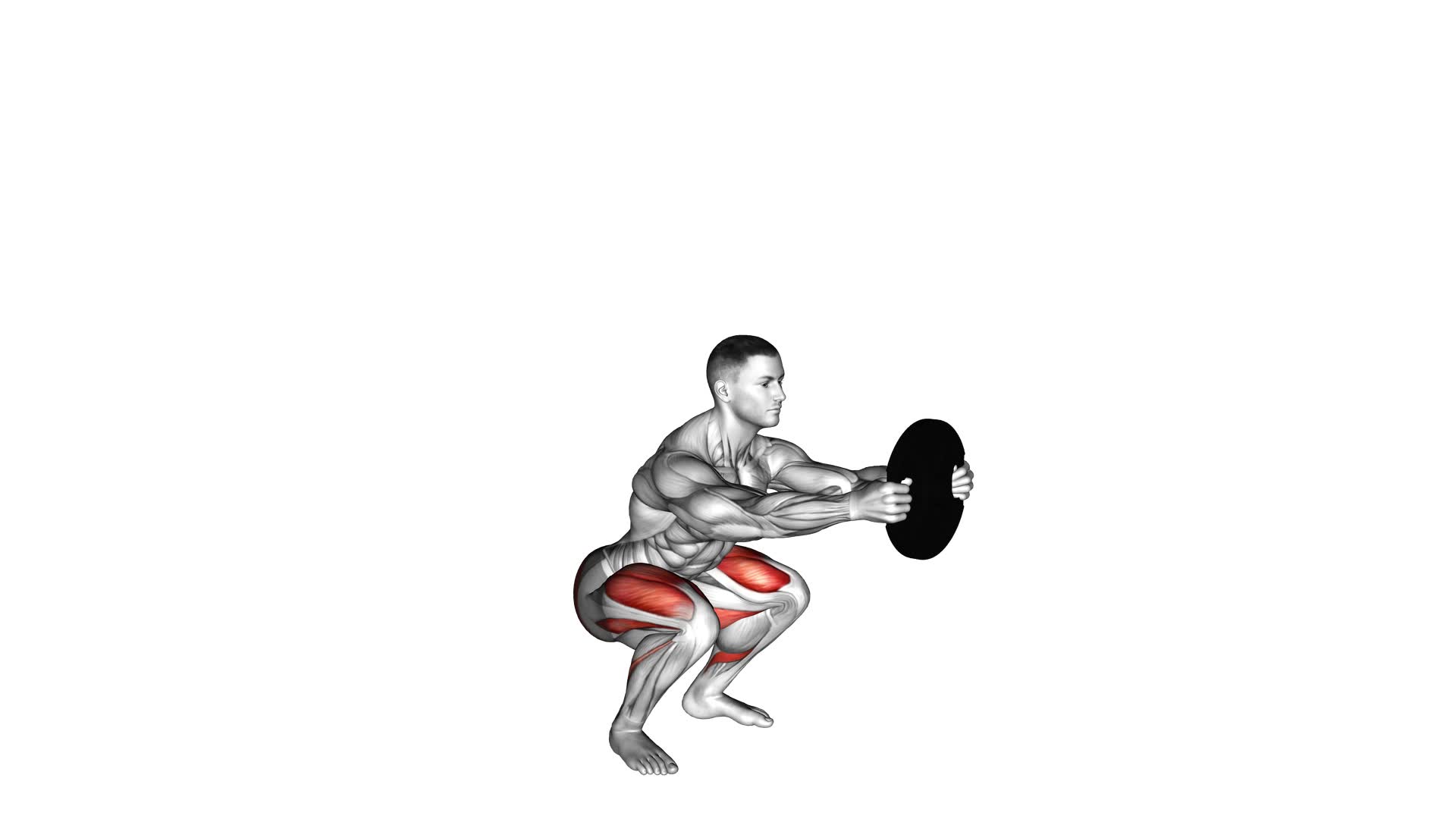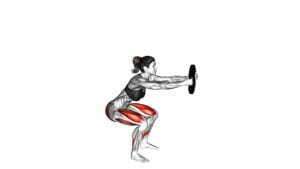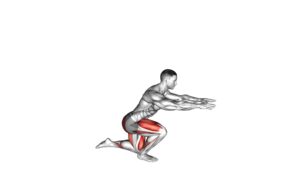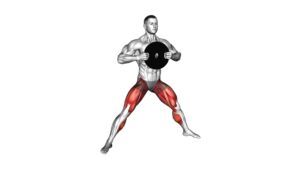Weighted Counterbalanced Squat (male) – Video Exercise Guide & Tips

Are you looking to improve your squat technique and build strength in your lower body?
Watch This Exercise Video
Check out this video exercise guide for the weighted counterbalanced squat. In just a few minutes, you'll learn proper form, variations, and common mistakes to avoid.
With these tips, you'll be able to maximize gains and prevent injury during your workouts.
So grab your weights and get ready to take your squats to the next level!
Key Takeaways
- The Weighted Counterbalanced Squat is a compound exercise that targets multiple muscle groups and promotes strength and muscle growth.
- Engaging core muscles and maintaining proper form and technique is crucial to prevent injury and maximize gains.
- Different variations and progressions of the exercise can be used to challenge the lower body muscles.
- It is important to start with lighter weights and gradually increase, while listening to your body and avoiding discomfort or pain.
Equipment Needed for the Weighted Counterbalanced Squat
To perform the Weighted Counterbalanced Squat, you'll need a barbell and weight plates. The barbell is a long metal bar that you'll hold onto during the exercise, and the weight plates are discs that you'll add to the ends of the barbell to provide resistance. There are different types of weight plates available, such as iron plates, rubber-coated plates, and bumper plates.
Iron plates are the most common and are made of solid metal, while rubber-coated plates have a layer of rubber around the metal for protection and noise reduction. Bumper plates are made of rubber and are designed to be dropped from overhead without damaging the floor or the plates themselves.
The benefits of performing the Weighted Counterbalanced Squat with the appropriate equipment are numerous. The added weight helps to increase the intensity of the exercise, challenging your muscles and promoting strength and muscle growth. The counterbalanced position of the barbell also helps to engage your core muscles, improving stability and balance. Additionally, squats are a compound exercise that targets multiple muscle groups, including the quadriceps, hamstrings, glutes, and core.
Now that you know the equipment needed for the Weighted Counterbalanced Squat, let's move on to the next section and discuss the proper form and technique for performing this exercise.
Proper Form and Technique for the Weighted Counterbalanced Squat
To perform the Weighted Counterbalanced Squat with proper form and technique, you need to ensure that you maintain a stable and balanced position throughout the exercise. Start by standing with your feet shoulder-width apart and your toes slightly pointed outward. Hold a weighted barbell across your shoulders, resting your hands on the bar. This counterbalanced position allows for greater stability and reduces strain on your lower back.
As you begin the squat, inhale deeply and engage your core muscles. Lower your body by bending your knees and pushing your hips back, keeping your chest up and your back straight. Aim to lower until your thighs are parallel to the ground, or as close as you can comfortably go. Exhale as you push through your heels to return to the starting position.
Proper breathing technique is crucial during the weighted counterbalanced squat. Inhale deeply before starting the squat and exhale as you push through your heels to rise back up. This helps to stabilize your core and maintain proper form throughout the exercise.
The benefits of the weighted counterbalanced squat include strengthening your lower body muscles, such as your quadriceps, hamstrings, and glutes. It also engages your core muscles, improving your overall stability and balance. Additionally, this exercise can help increase your lower body strength, which can be beneficial for various sports and activities. Remember to start with a weight that you can handle comfortably and gradually increase as you become stronger.
Variations and Progressions for the Weighted Counterbalanced Squat
As you progress in your weighted counterbalanced squat training, you can explore various variations and progressions to challenge your lower body muscles even further. Here are some advanced techniques for weighted counterbalanced squat progressions:
- Pistol Squats: This variation requires you to balance on one leg while performing the squat. It places greater demand on your quadriceps and glutes, as well as your core for stability.
- Jump Squats: Adding an explosive jump to your squat increases the intensity and power of the exercise. It targets your leg muscles and helps improve your vertical jump and overall athleticism.
- Bulgarian Split Squats: This exercise involves elevating one foot behind you on a bench or step while performing the squat with the other leg. It helps to improve balance, stability, and unilateral leg strength.
- Overhead Squats: Holding a barbell or dumbbells overhead while squatting engages your shoulders, core, and upper back muscles, in addition to your lower body. It enhances overall strength and stability.
Common Mistakes to Avoid During the Weighted Counterbalanced Squat
When performing the weighted counterbalanced squat, be mindful of the following common mistakes to avoid.
First, make sure to maintain proper form throughout the exercise. One common mistake is rounding your back, which can put unnecessary strain on your spine. To prevent this, focus on keeping your chest up and your back straight throughout the movement.
Additionally, avoid letting your knees collapse inward. This can cause instability and increase the risk of injury. Instead, push your knees outwards, in line with your toes.
Another mistake to avoid isn't going deep enough in the squat. Going through a full range of motion is important for targeting the muscles effectively. Aim to lower your hips until they're below parallel with your knees.
Finally, be cautious of using too much weight. It's essential to start with a manageable load and gradually increase it as you gain strength and confidence.
Tips to Maximize Gains and Prevent Injury During the Weighted Counterbalanced Squat
To maximize gains and prevent injury during the weighted counterbalanced squat, it's important for you to focus on maintaining proper form and technique. Here are some tips to help you achieve that:
- Warm up properly: Before starting your weighted counterbalanced squat, make sure to warm up your muscles and joints. This will help increase blood flow, improve flexibility, and reduce the risk of injury.
- Start with lighter weights: If you're new to the weighted counterbalanced squat, it's best to start with lighter weights and gradually increase the load as you become more comfortable and confident with the exercise. This will allow your muscles to adapt and minimize the risk of strain or injury.
- Engage your core and maintain a neutral spine: Throughout the exercise, focus on engaging your core muscles and keeping your spine in a neutral position. This will help stabilize your body and prevent unnecessary stress on your lower back.
- Listen to your body: Pay attention to any discomfort or pain during the exercise. If something doesn't feel right, stop immediately and reassess your form. Pushing through pain can lead to injury, so it's important to prioritize your body's signals.
Frequently Asked Questions
How Many Repetitions and Sets Should I Do for the Weighted Counterbalanced Squat?
To determine the number of repetitions and sets you should do for the weighted counterbalanced squat, it's important to consider your fitness goals and current fitness level.
Generally, it's recommended to start with 3-4 sets of 8-12 repetitions. However, if you're a beginner, you may want to start with lighter weights and fewer repetitions.
As you progress, gradually increase the weight and number of repetitions to challenge your muscles and promote growth.
Can I Perform the Weighted Counterbalanced Squat if I Have a Knee Injury?
Yes, you can still perform the weighted counterbalanced squat even if you have a knee injury. However, it's important to make modifications to avoid further damage.
Consult with a physical therapist or trainer to learn proper form and modifications specific to your injury. They can guide you on how to perform the exercise safely, such as using lighter weights, reducing the range of motion, or using alternative exercises that put less stress on the knees.
Is It Necessary to Use a Barbell for the Weighted Counterbalanced Squat, or Are There Alternative Equipment Options?
You don't necessarily need to use a barbell for the weighted counterbalanced squat. There are alternative equipment options available.
However, using a barbell has its benefits. It helps in adding resistance and increasing the intensity of the exercise, which can lead to better muscle development and strength gains.
But if you prefer or need to use alternative equipment, there are options like dumbbells or kettlebells that can still provide a challenging workout.
Can I Incorporate the Weighted Counterbalanced Squat Into My Cardio Workout Routine?
Yes, you can definitely incorporate the weighted counterbalanced squat into your cardio workout routine.
By adding weights to this exercise, you aren't only increasing the intensity of your cardio workout, but also reaping the benefits of the weighted counterbalanced squat.
This exercise helps strengthen your lower body muscles, improves balance, and burns more calories.
What Are Some Recommended Exercises to Complement the Weighted Counterbalanced Squat for a Full Lower Body Workout?
To have a full lower body workout, there are some recommended exercises you can try.
These exercises will complement the weighted counterbalanced squat nicely. Consider adding lunges, deadlifts, and hamstring curls to your routine.
Lunges work your glutes, quads, and hamstrings. Deadlifts target your hamstrings, glutes, and lower back. Hamstring curls specifically focus on your hamstrings.
Conclusion
In conclusion, the weighted counterbalanced squat is an effective exercise for targeting the lower body muscles and improving overall strength and stability.
By using proper form and technique, varying the weight and progression, and avoiding common mistakes, you can maximize your gains and prevent injury.
Remember to always prioritize safety and listen to your body's signals.
Incorporate this exercise into your routine for optimal results.

Author
Years ago, the spark of my life’s passion ignited in my mind the moment I stepped into the local gym for the first time. The inaugural bead of perspiration, the initial endeavor, the very first surge of endorphins, and a sense of pride that washed over me post-workout marked the beginning of my deep-seated interest in strength sports, fitness, and sports nutrition. This very curiosity blossomed rapidly into a profound fascination, propelling me to earn a Master’s degree in Physical Education from the Academy of Physical Education in Krakow, followed by a Sports Manager diploma from the Jagiellonian University. My journey of growth led me to gain more specialized qualifications, such as being a certified personal trainer with a focus on sports dietetics, a lifeguard, and an instructor for wellness and corrective gymnastics. Theoretical knowledge paired seamlessly with practical experience, reinforcing my belief that the transformation of individuals under my guidance was also a reflection of my personal growth. This belief holds true even today. Each day, I strive to push the boundaries and explore new realms. These realms gently elevate me to greater heights. The unique combination of passion for my field and the continuous quest for growth fuels my drive to break new ground.



